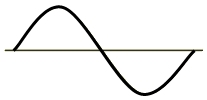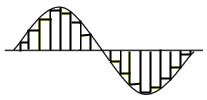 ANALOGUE
VS. DIGITAL
ANALOGUE
VS. DIGITAL 

They wrote hundred of
pages on this topic so I will add few personal ideas only.
- because these thoughts make sense, the first condition is you get a good quality audio device (and ears of course ;-) ) to discriminate at least the difference between a musical track reproduced from an MP3 file and the same one from a standard CD. -Second one is you get high quality recording to listen to.
- I deliberately missed out any reference to technical digital problems as jitter and alias and how they can affect the sound.
- The human ear working system is analogue as all the sounds in nature.
- Therefore ears and brain elaborate again every sound processed by D/A converters to feel it as natural as possible. In a long time listening session or at high volume level this "subliminal elaboration" generates the so called "listening weariness" which is directly proportional to the work amount done by your ear/brain system to rebuilt the original musical signal.
- This is, in my opinion, the greater limit of the digital recordings in their today most common format: the CD sampled at 44,1 KHz 16 bit resolution. The oversampling technology used in some CD player doesn't resolve the problem adding jitter distortion and can't recreate the original signal part missed using the 16 bit resolution. We can have a simple comparison with the imagine technology to better understanding. In this field our eye/brain system has to work hard to rebuild imagines as real as possible. Looking at old films affected by a great flickering you get tired and the images are far from reality. Things go better looking at the modern fast motion 35 mm films: less weariness and better image quality nearby the reality. This is true in video field too looking at interlaced or progressive video signal: the second one is smooth, less flickering (so the imagines are more natural and relaxing) than the first one. In the same way the higher resolution (bit word length), the best digital signal nearby the original analogue sound. This means less work for our “subliminal elaboration” and less “listening weariness” by consequence.
- Digital recording doesn't (yes DOESN'T) have more dynamics than analogue one. At 16 bit resolution usually they lost the 10 LSB (Last Significant Bits). This means you have 40db about dynamics! At 24 bit they have 14 full bit signal that means 80 db about dynamic. Exactly the same of reel to reel recorder with modern tape. But RtR has a greater headroom with "smooth and harmonic" distortion not "breath (and sound) taking" digital one.
- When you have bad recording, mastering or poor quality audio devices, digital system adds unnatural imprinting to the musical signal (something like a loss of harmonics and air around the instruments IMO) and, in worse cases, a totally wrong timbre of the wind and strings instruments.
- Analogue system gives you a smooth, natural, superior quality sound. On the other hand is more expensive, larger, difficult to handle and this hurt with our today lifestyle ( . . . of
course we can discuss about our lifestyle today is right or not . . .
). Ans is still unsurpassed system to store safely data for long time (see here)
- To resume: I
guess it has no sense to compare two systems using totally different
working way and state a winner. More: some people likes analogue sound,
other one digital. As someone prefers chocolate and other one prefers
cream; but usually theses taste are dished together!
My be this is the best solution at the moment: two systems living together in a pacific way. You can listen to an MP3 while are travelling or jogging, a CD as background while you are working and a tape or a vinyl if you can (you MUST!) stay for a while to relax listening to the REAL music.
- At least: never forget on the market there are excellent digital devices and very bad analog ones and vice versa. This can generate a big confusion at first listening.
MAGNETIC
TAPE VS VYNIL DISC
Ended the analogue/digital war, lets start up another one ! :-))

Premise: keep
in mind ALL musical recordings from the 50ties to the 90ties
were
realized using reel to reel
studio recorders mainly Studer, Telefunken, Ampex (fewer Otari,
Tascam e Sony). So every vinyl pressed in these years comes from reel
to reel analogue master (and you should just start thinking something
about this fact...). Every event of human history of the last century
was
recorded on magnetic tape (audio or video) and there are million
hours of analogue recording world wide. The digital recording,
mastering and supports kept definitively the control of the market
from the second half of 90ties.
- When you decide to listen to a good quality analogue recording your first thought is the vinyl disc (especially here in Italy and Europe where pre-recorded tapes were less diffused than in USA).
-
Well,
but how they produced a 33 rpm vinyl disc?
In a very simply way: starting from the analogue master tape 1) the musical signal is filtered on both bass and high frequencies (to be contained within the physical limit of the disc trace) and 2) equalized according to the standard RIAA curve: 3) the modified signal is sent to a mechanical lathe to produce the matrix; 4) from the matrix they obtain a cast; 5) the vinyl is pressed using the cast. There are 5 different steps (the much part of them are mechanicals) starting from the original master tape.
When a vinyl is reproduced the RIAA de-emphasis has to be applied to obtain again the original musical signal (and because of this hundred of phono preamps were build world around and thousands of pages have been written on them).
- How they produce a pre-recorded tape? Starting from the original master tape 1) “n” reel to reel recorders parallel linked copy the original master tape without any kind of electrical filtering or mechanical passage (tape has no physical limit as vinyl). 1 step only. To reproduce a prerecorded tape you need only an high quality tape recorder well aligned according to the international standard. That's all.
Mull
it over, people, mull it over . . .


 At
last few words about the analog support life (see the tape
page too). A well preserved and average used 50 years old
tape
sounds exactly as brand new.
This
is not always true for the vinyl suffering because of scratches,
dust, hard use, etc. Keep in mind the stylus applies a force to the
groove equal to 1 ton on 0,4 square inch that warms up and wears out
the vinyl at every passage!
At
last few words about the analog support life (see the tape
page too). A well preserved and average used 50 years old
tape
sounds exactly as brand new.
This
is not always true for the vinyl suffering because of scratches,
dust, hard use, etc. Keep in mind the stylus applies a force to the
groove equal to 1 ton on 0,4 square inch that warms up and wears out
the vinyl at every passage!

All rights reserved. © 2007 - 2015 Cesare Marchesini. Legal statement, sources, contents reproduction: please refer to the home page








